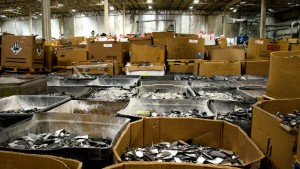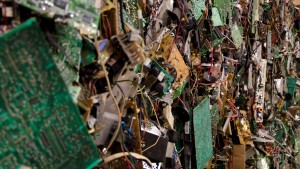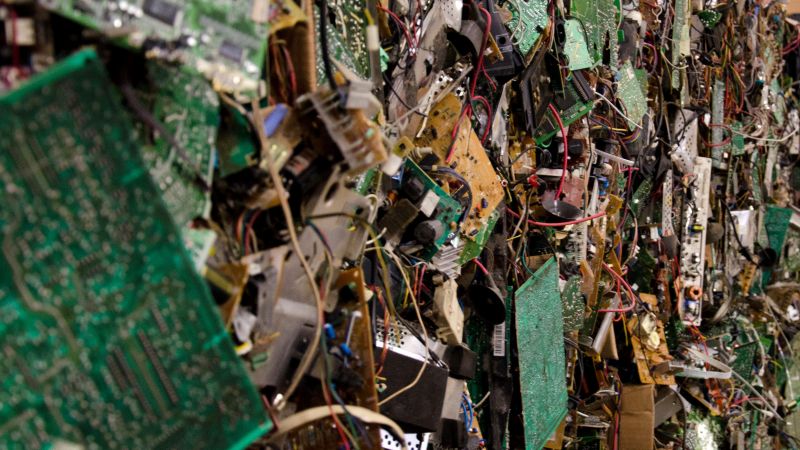“You can see behind the employees the conveyor with all the CRT picture tubes,” Corwell explains. “And those tubes are going up into the machine that separates the leaded glass from the borosilicate, or panel, glass. From there it goes into another machine that we built that actually cleans the glass so we can send it back to the glass manufacturers for reuse.”
Since Wisconsin's E-waste law took effect last year, Cornwell has added over 40 new employees at the Janesville facility. And while the state did not keep ewaste data before the program began, they have seen a 34% increase in ewaste collections in the last 6 months. The law has helped take in what would have languished in someone’s basement or, worse, been dumped illegally in a landfill. Illegal because all of that e-waste is loaded with nasty chemicals and heavy metals like lead, cadmium and mercury.
Sheila Davis is executive director of the Silicon Valley Toxics Coalition, based in San Jose, California. Davis says that there are over 4,500 chemicals that are used to make a flat-panel display in your average television set.
“And the same with your computer,” Davis adds. “There's over a thousand different kind of chemicals that go into making an integrated circuit board in your computer console. That's a lot of chemicals and when you throw them away, those chemicals go somewhere. And right now there's really not a safe place for them to go.”

That's why Wisconsin and 23 other states have enacted so-called “take-back” legislation over the past decade. The laws require electronics manufacturers to provide for the collection and recycling of e-waste. In Wisconsin, manufacturers need to collect and recycle 80 percent of the amount of electronics they sell in the state. If they can't collect that much, they're fined. But Wisconsin’s law is different than many of the other states with ewaste laws. And that’s making it difficult for electronics producers, says Walter Alcorn, a vice president with the Consumer Electronics Association, an industry group based in Washington, D.C.
“There’s some, I believe 19 different sets of registration requirements that exist across the states,” Alcorn explains. “These create additional compliance costs that really don’t go toward getting more electronics recycled, which is ultimately the goal of this whole effort I believe.”
Alcorn adds that a federal E-waste law would eliminate some of the redundancies as well as what he calls the “dead weight” costs of administering 24 different programs.
“These are costs that don’t go toward collecting or recycling used electronics, but go to something else that would not be necessary if there were a national system for recycling electronics.”
Although there is a bill in Congress that would curtail E-waste exports to some developing countries, there is nothing in the works to coordinate producer responsibility. That’s because there is wide disagreement between the computer industry, TV industry, environmental groups, retailers, and other players over how strict a law should be, if there are fees involved, and other details that involve potentially billions of dollars in costs.
Jason Linell is executive director of the National Center for Electronics Recycling, a non-profit organization that assists in promoting recycling programs across the country. He suggests that a national takeback law might be easier to administer, but not all manufacturers will embrace it.
“It’s not something the industry will talk about a whole lot,” Linnell says. “But privately they’ll say, maybe it’s better that we only have 25 states now and not 50, because that’s a whole lot more people if we have all 50 states covered and potentially a whole lot more volume that we’d be responsible for collecting and funding the recycling of.”
New E-waste laws take effect this year in New York, New Jersey, South Carolina and Vermont. But even with them, one-third of Americans still live in states with no e-waste recycling laws. And until that changes, experts say, millions of obsolete cell phones, broken VCRs and unwanted TVs will keep heading for landfills.
Audio Slideshow
Additional Links:
 In a dark industrial building in south central Wisconsin, stacks of old television sets, computer monitors and electronic gadgets spread out as far as the eye can see..Jim Cornwell is the president of Universal Recycling Technologies in Janesville, Wisconsin and he's giving us a tour of what he calls the “cradle-to-grave” electronics recycling facility.
In a dark industrial building in south central Wisconsin, stacks of old television sets, computer monitors and electronic gadgets spread out as far as the eye can see..Jim Cornwell is the president of Universal Recycling Technologies in Janesville, Wisconsin and he's giving us a tour of what he calls the “cradle-to-grave” electronics recycling facility.
